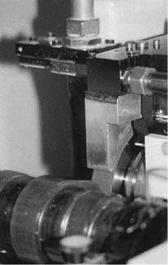A major drawback with higher wheel speeds is the increased demand for nongrind power. This relates, in part, to the increased frictional drag on the spindle. However, a far more significant factor is coolant drag on the wheel.
 |
The whole issue of coolant at high speed is problematic. Direct matching of coolant flow to wheel speed may require supply pressures over 1,000 psi to achieve a coolant velocity of 100 m/s. By 160 m/s the coolant pressure required would be >2,500 psi. Pressures over 1,000 psi will erode vitrified bonds, prevent the maintenance of laminar flow, and create major misting problems. Coolant is, therefore, often applied at low pressure (60 to 150 psi is typical) using a shoe-type nozzle such
 |
FIGURE 17.14 Shoe nozzle on Schaudt camlobe grinder for diesel cams. (From UGT 2000. With permission.)
that the wheel accelerates the coolant into the grind zone. If the coolant is applied successfully, this results in large drag forces on the grinding wheel. Once in the grind zone, the coolant also creates enormous hydrodynamic pressure just like a hydrodynamic bearing. This, in turn, creates high normal forces that manifest themselves as profile errors when grinding wide parts at speeds as low as 60 to 80 m/s using vitrified CBN wheels.
At 160 m/s, the force exceeds 20 N/mm wheel width using oil [Brinksmeier and Minke 1993]. The coolant also creates a great deal of resistance for wheel rotation. The combined effects of windage, spindle bearing, and coolant drag at 160 m/s can be as much as 2 kW/mm wheel width [Koenig, Klocke, and Stuff 1997]. This is also confirmed by field experience.
